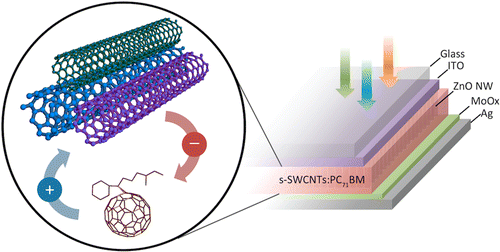August 18, 2014 report
Researchers unveil new solar cell made from carbon nanotubes that converts more sunlight into power

(Phys.org) —A team of researchers with members from several research facilities in the U.S. has unveiled a new type of solar cell based on single walled carbon nanotubes (SWCNTs). In their paper published in the journal Nano Letters, the team claims they have overcome limitations with such technology resulting in a solar cell that is two times as good at converting sunlight into power as other SWCNT based cells.
Scientists would like to use carbon nanotubes in solar cells because it would mean lighter panels, lower costs and easier to make products. They've been hampered, however, by the limited amount of power that such cells are able to generate. In this new effort the research team claims they've overcome the limitations of prior generations of SWCNTs by adding more chiralities to the nanotubes. Chiralities describe the way atoms are arranged in their hexagonal patterns—different patterns allow for absorbing different portions of the solar spectrum. Most prior efforts have used just one. This new team has added what they call polychiral SWCNTs to their cells which allows for capturing much more of the solar spectrum—most notably, in the near infrared, which other cells don't make use of at all.
The researchers also added an ability to control the interface between the underlying hole-transport layer and the active photovoltaic layer, allowing the electron and hole pair (excitons) to recombine more efficiently. Taken together the two improvements serve to allow for both higher current and voltage, resulting in record high power conversion efficiency. They report that The National Renewable Energy Laboratory has already certified (by verifying) the performance claimed by the team. But the team isn't done just yet. They want to improve the power conversion efficiency even more and may do so by testing new materials not used in any other cell.
While it could be awhile before a product is made for sale based on what the team has wrought, their research might cause others in the field to take notice, which could conceivably result in a resurgence of interest in carbon based solar cells in general—interest has lagged in recent years as researchers began to doubt they could make them both useful and profitable. Hopefully so, because it would mean less expensive (and lighter) solar panels that produce as much power as conventional panels or even more—leading perhaps to a major move from greenhouse gas emitting coal fired power to something much cleaner.
More information: Polychiral Semiconducting Carbon Nanotube–Fullerene Solar Cells, Nano Lett., Article ASAP, DOI: 10.1021/nl5027452
Abstract
Single-walled carbon nanotubes (SWCNTs) have highly desirable attributes for solution-processable thin-film photovoltaics (TFPVs), such as broadband absorption, high carrier mobility, and environmental stability. However, previous TFPVs incorporating photoactive SWCNTs have utilized architectures that have limited current, voltage, and ultimately power conversion efficiency (PCE). Here, we report a solar cell geometry that maximizes photocurrent using polychiral SWCNTs while retaining high photovoltage, leading to record-high efficiency SWCNT–fullerene solar cells with average NREL certified and champion PCEs of 2.5% and 3.1%, respectively. Moreover, these cells show significant absorption in the near-infrared portion of the solar spectrum that is currently inaccessible by many leading TFPV technologies.
Journal information: Nano Letters
© 2014 Phys.org




















